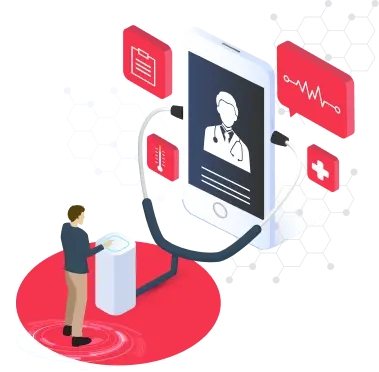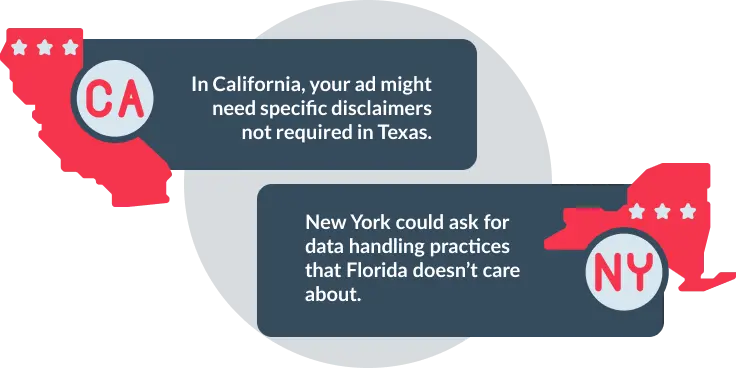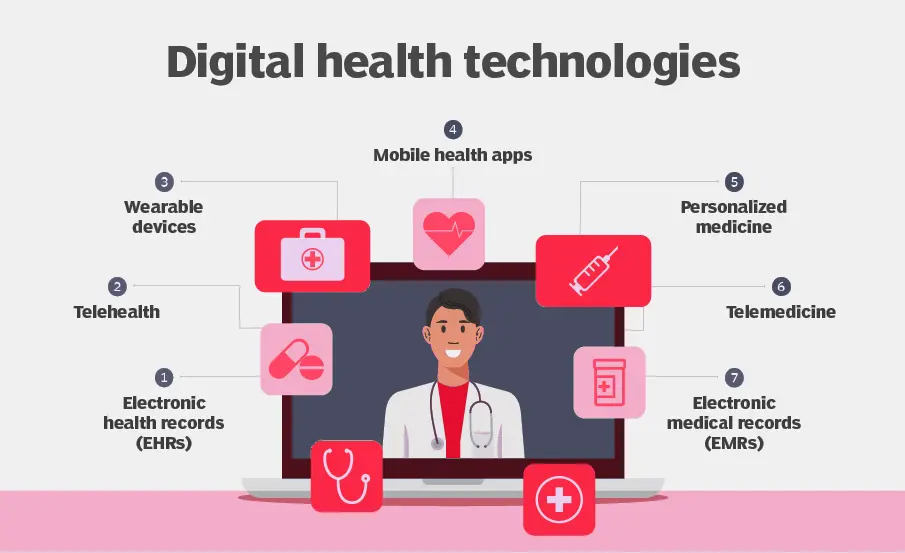Table of Contents
Have you ever been part of a spacing emerging so quickly, it’s palpable?
That’s exactly what’s happening in the realm of digital health marketing. It’s a seismic shift, shaking up how we connect with audiences. Ever tweet, every search engine query, and new digital health product–it’s all part of an intricate dance between technology and human progress.
The digital health ad landscape isn’t just evolving; it’s morphing at warp speed. At this juncture, healthcare firms stand at a pivotal intersection, deliberating their next move amidst the rapidly transforming terrain. The old paths are eroding away under the relentless tide of innovation and changes in regulation.
A staggering 75% of healthcare marketers believe that their digital efforts significantly impact patient decisions. Yet only half feel prepared to meet these challenges head-on. How to explain that?
It’s not just about adding a new tagline or making a good video about your product or services. It’s deeper than that.

Performance Marketing is Especially Complex for Digital Health
Diving into the world of digital ads reveals a battleground where innovation and flexibility in marketing approaches are crucial to stay ahead.
Understanding the Competitive Arena
Digital health companies are competing with other industries in a crowded ad space in which grabbing attention is key. So how do you stand out? It’s definitely not about being louder or more visible. It’s about being smarter and more strategic.
The key for digital health marketing? First, all the classic marketing rules apply: set the strategy first, center on and know your ideal audience, tune your high level mix of marketing channels (content marketing, email marketing, SEO strategy), measure the marketing performance with analytics tools, balance performance and brand awareness, and iterate. As we outline below, the ad piece changes fast enough to keep us busy, and then we layer on the regulations and compliance aspects specific to performance marketing for digital health (which healthcare professionals know and love), and the work gets considerably more complex. Expertise and experience are at a premium.
The Evolution of Digital Advertising
Gone are the days when a simple banner ad would do the trick. Technology has changed. People have changed. Nowadays, we’re seeing ads tailored just for you by AI, virtual reality that pulls you into another world, and content that talks back to you, revolutionizing how we connect with healthcare on a deeply personal plane.

AI:
Not just for sci-fi movies anymore; it’s making ads smarter every day.

VR:
Healthcare marketing isn’t just telling; it’s showing now—in 360 degrees.

Interactive Content:
Get people clicking with quizzes and assessments tailored to their healthcare journey.
KEY STATS
The digital ad landscape is highly competitive and constantly evolving.
The clear bottom line here is that the game has changed. Technology & consumer behavior shifts mean one thing: if you want to stay ahead, you’ve got to keep up—and get creative while you’re at it.
So let’s roll up our sleeves and dive headfirst into this brave new world together.
The Regulatory Maze of Digital Health Marketing
Navigating the ever-shifting landscape of digital health marketing regulations feels like trying to catch a cloud. Let’s navigate this together.
State-Specific Challenges
To target the US market as a digital health company, there are 50 states, 50 sets of rules, and 50 different “mixes” of payors (insurance companies–more on this later). That’s what state-specific regulations feel like in digital health advertising. Navigating through the maze of individual state regulations presents a formidable challenge for advertisers in the digital health sector.

This fragmentation means one thing: custom-tailored campaigns are a must. You can’t just create one campaign and hope it fits all; it won’t work.
However, this sort of fragmentation is the exact opposite of the scalable campaign structure that now is required on the paid social media and search engine platforms, on which the broader the addressable audience, the better the AI algorithm can tune in over time to show “the next right message to the next right person”.
Ensuring HIPAA Compliance
HIPAA compliance isn’t just a hoop to jump through—it’s essential for protecting patient privacy and maintaining trust. Compliance can become a competitive advantage instead of a frustrating requirement. That said, staying compliant while being creative in ads? It feels like tightrope walking without a net sometimes.

Sensitivity in Messaging: Always think before you finalize your message—Is this showing empathy to the person on the other side of the ad who may be seeing ads from various healthcare companies? Might this, in any way, compromise confidentiality? This is mostly a focus on paid approaches to social media, but this sensitivity is perhaps even more central to organic social media marketing

Data Handling: Only collect what you absolutely need, encrypt everything, make sure only authorized eyes see it, and delete when done using it.
The goal here isn’t just avoiding fines (though that’s important). Treating our audience’s privacy with the same care as we would want for ourselves is not just about compliance, but deeply honoring their trust. Because when we do that well? As trust flourishes, our business thrives alongside it, fostering a mutually beneficial relationship. HIPAA guidelines, while strict, help us maintain this balance by setting clear boundaries around patient information use in marketing efforts. Digital health marketing is indeed complex but remember: with great challenges come great opportunities—for those willing to navigate these waters carefully.
State-by-State Fragmentation in US Digital Health
Aside from the current creative and technical approaches needed to optimize ads for digital health, healthcare marketers know that performance marketing for digital health is changing fast, and the rate of change is accelerating. For example, matching up those who provide care with those who need it isn’t as easy as building out national marketing campaigns for brands in other segments. Why? Because your doc needs to be licensed in your state even in a telehealth environment.
Overcoming Geographic Limitations
Tactics for effectively marketing telehealth services within regulatory constraints.
The rules of the game say that providers and patients must play ball in the same state. At first glance, it seems straightforward, yet this regulation introduces a multifaceted challenge in synchronizing participants’ presence on the digital playing field.

Educate Your Audience: First things first, let people know why this matters. A quick explainer can go a long way in setting expectations right.

Decide / Test Fragmentation vs Consolidation: UTest consolidation of accounts and states whenever possible, to test how your improving your conversion rate at the form level might might counteract a diminished rate of leads that become appointments, for example.

Refine your Technical Setup: Assure your website, apps, and other digital properties are passing maximum signal back to the ad platforms (within the constraints your legal team’s particular compliance approach), and that you understand exactly what you are tracking, whether “true north” revenue KPIs or performance brand metrics at the level of a particular search engine or on social media and across your website content. (To do this correctly in digital health, this should be done by a programmer familiar with Google Tag Manager and Meta’s Conversion API (CAPI) at a minimum.)
We’ve got tech that lets us chat face-to-face with someone across the globe, yet finding an available provider in our own backyard feels like hunting for unicorns sometimes. However, recognizing these obstacles is akin to having already vaulted halfway across them, particularly when we persist in driving innovative remedies.
And remember, navigating these regulations, while tricky, ensures everyone gets safe and effective care – no matter where their GPS pin drops them.
In today’s world where convenience meets necessity at lightning speed, tapping into telehealth opens doors wide open — not just for accessibility but also for making real connections without borders…well except those pesky state lines. So let’s get smart about how we market these lifesaving services because there’s nothing more rewarding than bridging gaps between those who help and those who need healing.
The Importance Matching Supply and Demand for Patient Appointments
Ever faced the frustration of a missed doctor’s appointment? Yeah, it happens more often than we’d like to admit. But here’s the kicker: “no show” rates for new patient appointments shoot up significantly after just 4 days. This isn’t just about lost time; it’s a real hiccup in providing continuous care.
What strategies can medical professionals employ to sidestep this snag? Digital ads are not just billboards on the information highway; they’re lifesavers in disguise. Exploring the enchantment behind digital saviors reveals their method in weaving wonders.
Filling Open Slots Within the Upcoming Three Days
Digital ads come to the rescue by filling those open slots faster than you can say “appointment.”
They’re quick, efficient, and don’t play hard to get. The secret sauce? Timing and targeting.

Timing is everything: Catching potential patients’ eyes at the right moment makes all the difference.

Targeting with precision: Knowing your audience allows for messages that resonate personally, making them far more effective.
We live in an age where our online presence does half (okay maybe more) of our talking for us. So when we harness tools like Google Analytics or delve into social media campaigns tailored specifically towards bringing down those no-show rates… Well, let’s just say magic starts happening. It transforms empty slots into opportunities for someone who really needs that appointment but didn’t know there was one waiting just for them.
A Delicate Balance of Ad Spend, Scaling Volume, and Appointment Fill Rates
The adage old as time has never been truer when it comes to managing patient appointments efficiently through digital marketing strategies aimed at keeping both doctors’ schedules full and patients receiving timely care—making everyone involved healthier and happier along the way. Now that’s something worth investing your clicks into.
In today’s fast-paced world where every second counts especially in healthcare delivery – being able to swiftly fill up vacant appointment slots not only reduces ‘no shows’, but also ensures continuity in patient care which is crucial. Studies have shown this proactive approach benefits both provider efficiency and patient satisfaction immensely—a win-win situation indeed.
Building Awareness for Personalized & Preventative Healthcare
Folks, let’s talk about something that could really change the game: the combination of personalized medicine and preventative medicine. Far from being mere jargon, it signifies a transformative shift in our approach to maintaining health and vitality.
Educating Your Audience
So, you’re in the biz of personalized or preventative healthcare? Awesome. The first step to getting folks on board is education. And guess what? Digital marketing is your best friend here.
Digital ads aren’t just flashy banners anymore. These tools are now mighty in their capacity to narrate tales, enlighten folks, and indeed—enhance the quality of existence. Think about it: someone scrolling through their feed pauses because they see an ad addressing their exact health concerns with a solution tailored just for them. That’s impactful.

Show don’t tell:
Use real-life success stories in your ads to show the benefits of personalized medicine.

Get visual:
Infographics and videos can break down complex ideas into digestible pieces everyone can understand.

Solve Problems:
Position your service as the answer to common issues your target audience faces regarding their health care needs, whether on a search engine or a social media website.
The key stats back this up too—raising awareness isn’t just good karma; it drives growth and demand generation like nothing else (Forbes Health). By using digital ads smartly, you create those lightbulb moments for potential patients where they think, “Hey, this makes sense for me.” And suddenly, you’re not selling anything; you’re providing value that stands out in today’s competitive market.
This journey towards educating and converting folks doesn’t happen overnight but stay patient (pun intended). Every click-through from an ad means another person who’s now aware that there are more personal options out there tailored to their unique needs—and that’s pretty darn cool if you ask me.
IN SUM:
Educate creatively through digital marketing channels while focusing on delivering genuine value—it’s how we start making waves in preventive healthcare together.
The Role of Measurement in Performance Marketing
Let’s talk performance metrics. We’re plunging into the realm of key performance indicators for digital health promoters, steering clear from the mundane. Because guess what? Understanding the full funnel and which marketing tactics are working to drive your website traffic and online performance involves understanding what’s needed in a reliable technical setup (conversion tracking), so that metrics up and down the funnel can be trusted via a “source of truth”.
Key Metrics to Watch
First off, if you think all metrics are created equal, think again. Some are game-changers and others… well, they just take up space on your dashboard.

Conversion Rates:
This is your bread and butter. It tells you how many site visitors turn into customers or patients. High conversion rates? You’re doing something right.

Bounce Rates:
If people hit your site and leave faster than they can say “healthcare,” it’s a sign something’s amiss with your user experience or content.

Traffic Sources:
Knowing where your visitors come from lets you double down on what works—be it social media campaigns or search engine optimization efforts.

Email Open Rates:
In healthcare marketing, emails can be goldmines for engagement—if people actually open them. Low rates might mean it’s time to spice up those subject lines.
Navigating today’s cutthroat arena, possessing such metrics isn’t merely beneficial; it becomes essential for flourishing and enduring. Think about measurement as a GPS guiding through the dense forest of digital marketing strategies toward clear skies and solid ground—the promised land of high ROI and effective campaigns that resonate with potential patients far and wide.
We know measuring performance feels like one more thing on an already full plate (especially when navigating HIPAA compliance). But trust us—it pays off by showing exactly where to focus energy (and budget) for maximum impact without playing guessing games because nobody has time for that.
To wrap this up: always keep an eye out for new tools popping up offering even deeper insights because staying ahead means never resting on laurels—or outdated analytics platforms.
Partnering with a Performance Marketing Agency
Diving into the digital health space? Venturing into this realm feels akin to exploring uncharted territories. A world where understanding the pulse of your audience can make or break your campaign. But here’s the kicker: navigating this landscape is no small feat.
Why Specialization Matters
Ever wonder why some digital health campaigns just seem to ‘get it’ while others miss the mark? The secret sauce often lies in specialization. Let’s talk about why teaming up with an agency that knows the ins and outs of digital health advertising isn’t just nice—it’s essential. (Not to mention agencies can solve a lot of problems like bandwidth, expertise, and more.)

Insider Knowledge: These agencies speak fluent healthcare. They know what makes your target audience tick, which regulatory hoops you need to jump through, and how to communicate complex ideas simply.

Creative Compliance: Navigating regulations like HIPAA doesn’t have to stifle creativity. Expert agencies ingeniously navigate the delicate balance, ensuring your narrative is conveyed without overstepping boundaries.

Data-Driven Strategies: With access to specialized tools and data sources, these agencies don’t play guessing games with your marketing strategy—they base decisions on solid analytics tailored for healthcare industry trends.

Patient-Centric Campaigns: Ultimately, it’s all about connecting with potential patients in meaningful ways. Agencies steeped in digital health understand patient concerns, needs, and behaviors better than anyone else.
The bottom line? When you partner with an agency that gets it—really gets it—you’re not just investing in ads; you’re investing in smarter strategies designed from ground-up for folks exactly like those you aim to serve. That’s game-changing.
Joining forces with such an agency transcends the usual commercial exchange, transforming into a shared quest to forge meaningful bonds and authentically enhance human experiences via adept technological interventions.
If there ever was a time when specialization mattered most – especially within today’s competitive healthcare market – it’s now.

Frequently Asked Questions in Relation to Performance Marketing for Digital Health
What is performance marketing?
Performance marketing captures an strategic approach that is judged by data that balances the marketing inputs vs outputs, often financial metrics like ROI (return on investment). It implies a full funnel approach the requires the performance team to be able to optimize up and down the funnel, from positioning and messaging around the offer, the ad copy and creative iterations, to the landing page and an understand of the event that drives revenue.
What is digital health?
Digital health “meets patients where they are” in extending care through mobile devices and computers in a telemedicine environment. It includes a pro-active and innovative approach to healthcare in which the patient uses their own data to develop a personalized and preventative approach to their health. It connects patients with solutions they need online.
Why is digital health performance marketing different from marketing that hospital groups or urgent care clinics might do?
While telemedicine and telehealth can help patients who are sick and already in need of care, our vision of digital health unlocks proactive and personalized approaches for each patient that lengthen health span and prevent the need for visits to hospitals and urgent care clinics. In this way, we truly promote healthcare rather than “sickcare”.
Conclusion
Thus, we’ve provided an overview of the changing terrain of online wellness promotion. The digital ad space isn’t for the faint-hearted; it demands creativity, adaptability, and a knack for standing out in a crowd.
We touched on the regulatory maze – understanding those pesky state-specific challenges and ensuring HIPAA doesn’t become our nemesis but rather a guide to better engagement.
Aligning supply with demand for near term appointments is often a guiding light, but as of now that state-specificity drives fragmentation which is a challenge for the ad networks.Timely appointments became less about luck and more about strategy because every empty slot filled is another step towards seamless patient care continuity.
And let’s not forget personalized healthcare – turning what sounds like sci-fi into tangible benefits that everyday folks get excited about. Education was our sword as we battled ignorance on why personalized care matters so much.
But wait – how do you know if any of this works? Measurement: and assuring the numbers don’t lie via proper technical setup. Tracking metrics turned from daunting task to daily guides – essential for growth and optimization alike.
In closing: thriving in performance marketing for digital health is advanced and therefore requires industry and ad platform expertise, technical and creative skill, collaboration, and partnership.
It’s a journey towards making things better together.